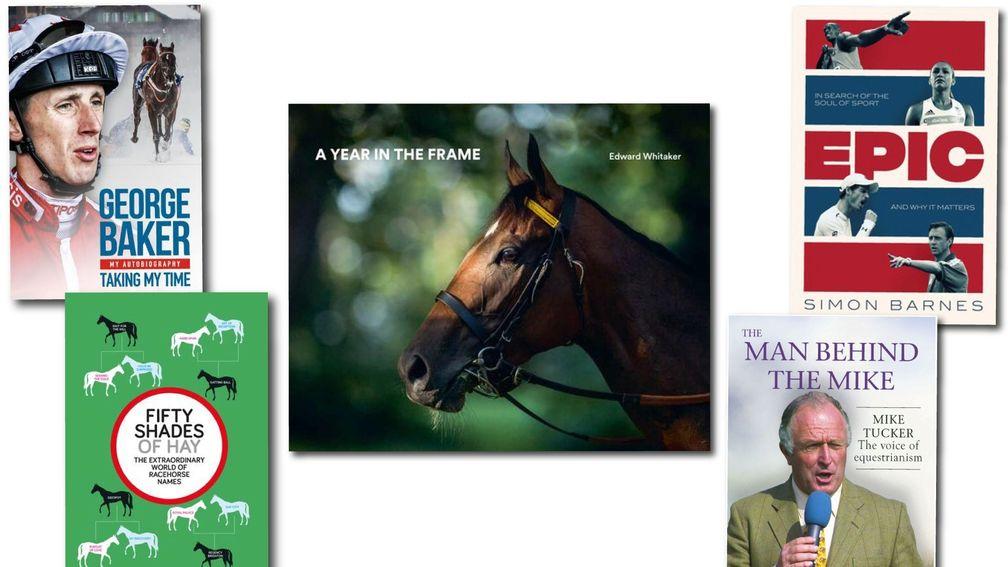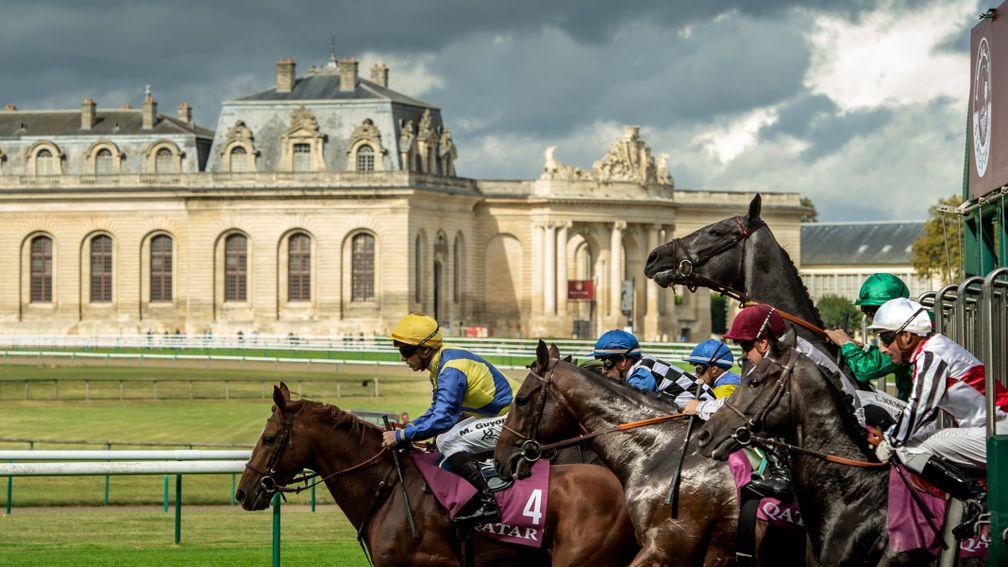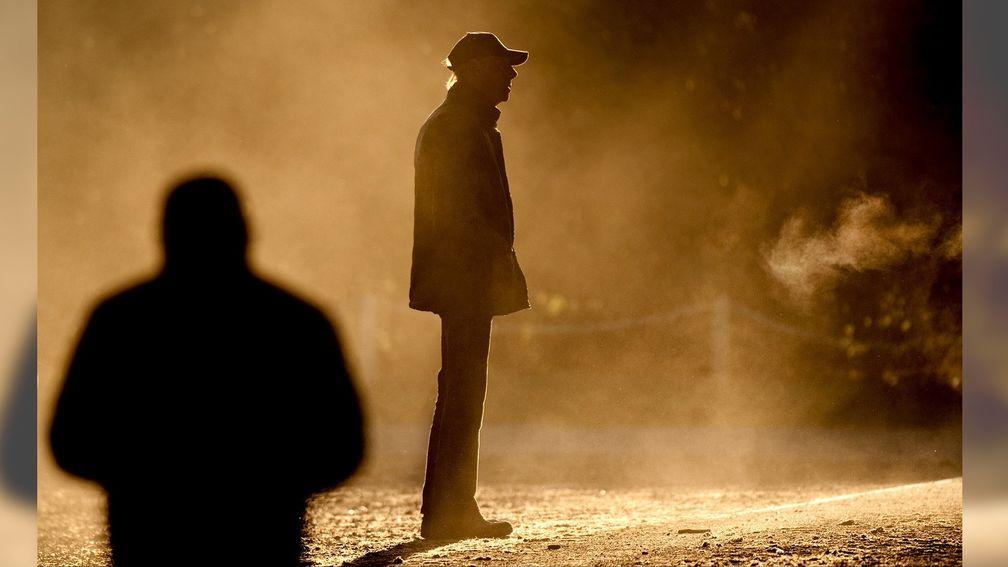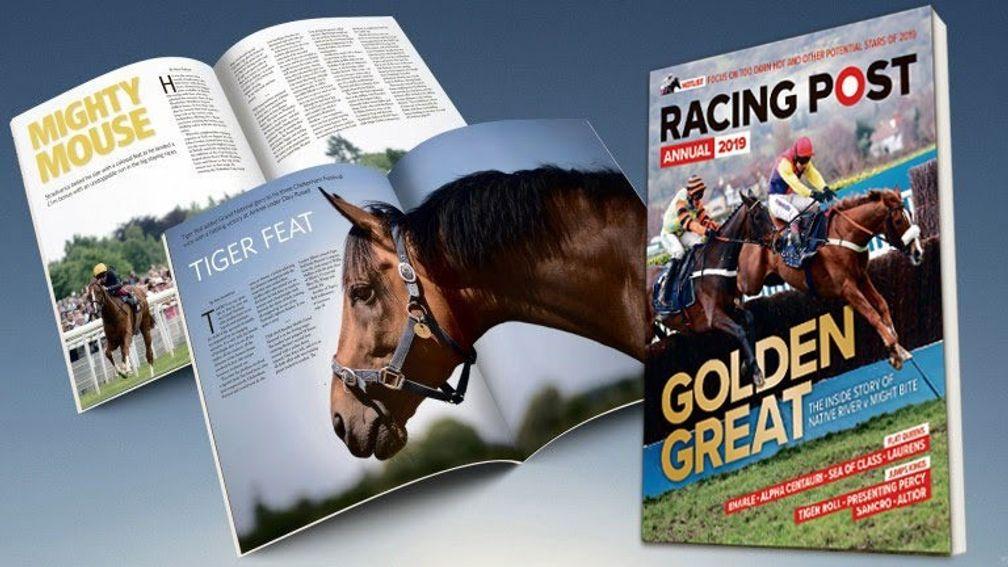Photographic perfection encapsulated in remarkable celebration of the sport

A Year in the Frame by Edward Whitaker
£25, published by Racing Post
If I were compiling a list of the things I have loved most about being editor of the Racing Post for the past 11 years, working with the astonishingly beautiful photographs of Edward Whitaker would be extremely close to the top.
It was once said of Alastair Down that he is not just the best racing writer or even the best sports writer out there, he is simply the best writer, and it is easy to feel the same about Edward, who is the undisputed king of racing photographers, and has been voted the best sports photographer but is arguably as good as anyone in any sphere with a camera on his shoulder.
His brilliance is encapsulated perfectly in A Year In The Frame, the fourth collection of his marvellous work and to my mind the finest.
It really shouldn’t be. Edward has been doing this for a long time and when you have done more than 30 Cheltenhams and 30 Royal Ascots there must be a temptation to rely on tried and trusted positions from which he knows he will be able to capture a killer image.
But what helps make Edward so special is that he never rests on his laurels and never believes he has exhausted his options when it comes to finding a new angle.
That is abundantly clear throughout this remarkable book, not least in the incredible shot of racing at Chester with the vista of the city in the background, which he took with the help of a 70-metre cherry picker.

There are no fewer than 174 pages of outstanding, stunning photographs to enjoy, presented month by month which enables readers to enjoy a long, leisurely feel for the hugely varied global racing landscape as it unfolds from January to December.
One of Edward’s many attributes is his ability to capture horses and humans with equal skill, and if I were choosing a person picture that sums up his outstanding nose for an eyecatching image it would be the shot of JP McManus standing alone on the platform at Plumpton station, catching the train back to town with a trophy he'd collected for yet another winner stowed safely in a bag.
But trying to select an overall favourite photograph from so many exceptional choices quickly becomes an impossible task. There truly are far too many to pick from.
As my time as editor comes to an end I’d like to use this review to pay tribute to Edward as a colleague and friend. This is not someone who just snaps away, submits his pictures and heads home.
He is justifiably proud of his work and communicates closely with the picture desk to help Racing Post readers get the best of his work.
When his number comes up on my phone it is almost always an indication that he has taken some great pictures and wants to ensure they get due prominence.
I have lost count of the times he has rescued an unpromising midweek edition by supplying a picture that has created an attention-grabbing front page, but will hopefully enjoy marvelling at his work from afar for many years to come.

Edward loves racing and loves horses, and if you do too it is almost impossible that you will fail to enjoy this exquisite collection of pictures that show what a wonderful sport racing is and how lucky it is to have a master like Edward Whitaker to capture its essence so perfectly.
Bruce Millington
Heartwarming tale of triumph over adversity in and out of the saddle
Taking My Time by George Baker
£20, published by Raceform
The pivotal moment in George Baker’s life was the career-ending injury he suffered in a horror fall on the White Turf at St Moritz in February 2017.
From its aftermath a second life has emerged and this honest and open account of the trauma he has been through is truly inspiring.
The former jockey decided to pen his story to provide closure on the accident and to ensure his young daughter, Isabella, had a record of his life as a top-class rider.
Baker rode horses from an early age and he describes how he became fascinated by them, as well as jockeys, and how he gained an insight into pace and the use of hands. He used those early experiences to good effect later as a professional.
He takes us through the start of his riding career and relates how a vicious battle with the scales began after an accident at Goodwood forced him out of the saddle for three months.
When he returned after the injury his physique had changed and weight became an issue that affected him for most of his career.
He gives a revealing insight into the daily struggle faced by jockeys as they try to keep their weight under control. Baker says that it becomes an obsession riders wish they didn’t have.
As well as weight, another demon entered his life in the shape of alcohol, and what happened to Baker is a common theme in the early careers of many a young sportsman.
He had too much time on his hands and his drinking, while not out of control, was becoming a problem and it came to a head when he failed to ride one afternoon at Kempton on a Sunday.
Baker describes the tough love he received from his agent Guy Jewell and how he took up golf to give him something to do when not riding. Meeting his future wife, Nicola, meant he also began the process of settling down.
As well as his agent, Baker also goes to great lengths to pay tribute to the people and horses who have played important roles in his life. These include trainers Chris Wall, Gary Moore and Roger Charlton, as well as Premio Loco, Quest For More and Seal Of Approval.
The equine star who receives the full red-carpet treatment is, of course, Harbour Law, who gave Baker his only Classic success in the St Leger at Doncaster in September 2016. Shortly afterwards his daughter was born. Everything was rosy in the Baker household until he boarded a flight to Switzerland in February 2017.
In the fall that changed his life Baker had multiple bleeds on the brain, suffered post-traumatic amnesia and had to learn to walk again.

In a slightly unusual move for an autobiography – but an understanding one nonetheless and hugely effective as Baker has little memory of the aftermath of the accident – his wife Nicola chronicles those moments as well as the start of his recovery. It is told with honesty and humour as she describes how family and friends are affected when a loved one is seriously injured.
Baker then takes up the story to detail his emotions as he completes mini-milestones during his recovery with wit and wisdom before his former colleagues from the weighing room and trainers pay their own tributes.
He has had to overcome serious physical and mental trauma to get to where he is today, so it is the triumph over adversity that makes this such an inspiring read. Baker is the same person but different.
Andrew Pennington
Goldmine of racehorse names yields rich reward for master of the craft
Fifty Shades of Hay: The Extraordinary World of Racehorse Names by David Ashforth
£12.99, published by Racing Post Books
A gallop through the infinite variety of racehorse names was a book waiting to happen but one that could easily have disappointed in the wrong hands. Fortunately, in David Ashforth, there could be no better writer to dig deep into the goldmine and polish the contents to the highest quality.
The subject of racehorse names – from the inspired to the insipid – has been touched on in other books but never explored as fully as it is here by Ashforth’s amused eye.
The many fans of Ashforth’s columns in The Sporting Life and Racing Post will delight in his distinctive approach: the passion for racing and its history, the meticulous research, the sometimes cutting comments and the love of the comical and the absurd. Humour in print is one of the most difficult skills, but Ashforth is a master and the raw material at his disposal is right up his street.
One of the earliest pieces of racing trivia acquired by most racing followers is that 18 characters (including spaces and symbols) is the limit for racehorse names. What many will not know is that Eighteencharacters the racehorse (born 2002) won once, at Tampa Bay in 2006, while another with the same name (born 2013) had won four times at time of writing, in California and Arizona.
Ashforth tells us about those two, and hundreds of others besides, in this work of impressive depth. Along the way, we are entertained by the inventiveness of name-givers and the impact of their choices of historical figures and popular culture, from Caligula to Cluedo and Captain Pugwash. Or Dolly Parton, whose equine namesake leads on to Dolly Smarten, by Smarten out of La Cleavage.
The subjects are grouped under chapter headings – 17 of them, such as Commentators’ Nightmares and Animal, Vegetable, Mineral – and Ashforth treats each horse and its name individually, in a simple but highly effective style.
For each pen portrait, Ashforth provides major race wins and the pedigree – the sire, dam and damsire – of the horse, which can of course be a clue to the pedigree of the naming. For instance, there is the little-known Secret Romance, by Clandestine out of Sunny Fling and winner of three of his 56 races in the US. “There have been better Secret Romances, but none with a better founded name,” notes Ashforth.
Many readers will no doubt turn immediately to the chapters Barred Names and Sexcetera, as Ashforth is well aware. When he asked for names to include in the book, “there was particular enthusiasm for sex and vulgarity, sometimes both,” he writes. “I like to think the suggestions were made with the intention of raising the tone of the book.”
The contents of those chapters are not being given away here, nor the top tens bestowed by Ashforth in the final chapter The Best of Names, the Worst of Names, but one great example of the naming art is worth highlighting as an example. Traffic Jam, winner of last year’s Prix du Conseil de Paris at Chantilly, is by Duke Of Marmalade out of Place de l’Etoile and applauded by Ashforth as “a terrific name: the Place de l’Etoile is a notorious road junction in Paris”.
At the other end of the scale is the filly Caravan Centre, “a terrible name for a horse, and one that killed any hope of winning the Derby or Oaks at baptism”.
With Christmas approaching, this book would make an excellent present. But to call it a stocking filler would be unworthy because this would be a treat at any time of the year. It’s just a wonderful book. Or, as it might appear in 18 characters, Justawonderfulbook.
Nick Pulford
Epic by name, epic by nature – Barnes's compilation a sports book like no other
Epic by Simon Barnes
£18.99, published by Simon & Schuster
A sports book that lacks an overarching narrative, structure, conclusion or message.
Instead, Epic weaves together many of the most iconic, controversial and unforgettable moments that coloured the 30-odd years of Simon Barnes's tenure as a sports writer at The Times.
It is an unlikely triumph, a chronicle of diverse vignettes that gradually lures you into an engrossing tome through which Barnes subtly conveys his perspective and values while at the same time leaving enough ambiguity for you to make up your own mind.
You shouldn't be able to distil the essence of Ronnie O'Sullivan's enigmatic genius, Ayrton Senna's imperishable impact or the unfathomable tragedies of Hillsborough and Heysel in brief illustrations of little more than a few hundred words, yet that is Barnes's exquisite gift.
Some characters, events and clashes are revisited, enabling a hint of chronological sequencing that ties the whole thing together. In totality, though, Barnes uses the prism through which he experienced these myriad episodes to deliver bitesize parables. Not morality tales, but enigmas to decipher ourselves.
Boxing is about the only topic on which he is unambiguous, although he also protests against ingrained gender bias. "They died because something went terribly wrong – not, as in boxing, because something went terribly right. Their deaths don't invalidate their lives or their sport," he writes of five riders who died in eventing falls.
Barnes doesn't impose his views on the reader, but, by somehow calling upon Joyce, Whitman, and, ah, Pretty Woman et al at various removes, he invites us to explore our understanding of sport.
Pretty much every discipline gets an airing, with Dancing Brave, Desert Orchid, Red Rum, Frankie Dettori and Quixall Crossett – yep! – all featuring for racing.
He has a sublime ability to bring you ringside without involving himself, guiding you into the amphitheatre before showing you your seat and then leaving you to appreciate the majesty of what unfolds. And to figure it out for yourself.
"Sport tries to separate itself from the real world, but the real world has never respected that wish. Part of sport's enduring beauty is this separation: it's all play, it's always fair, it's about joy, its deaths are metaphorical along with its victories and conquests and its promises of immortality. Sport must be separate from the real world if it's to have a meaning: and yet it can never complete that separation. So sport has settled on the illusion of separation, even though this illusion must be shattered again and again."
These are the sort of philosophical or existential questions posed by Barnes throughout, and he doesn't shy away from exploring issues of commercial, political and ethical nuances.
Nationalism and patriotism, function and flair, mind and body, cheating and integrity and ordinary versus extraordinary are the sort of binary forces he compels us to examine.
For this reader, Dawn Run, Sea The Stars, AP McCoy and Roy Keane vs Mick McCarthy are some of the more conspicuous subjects not broached, but on more than one occasion he writes with divine impiety on the rivalry between Ireland and England teams and its historic and political backdrop.
"The English have always envied the Irish, at least when not trying to kill them," goes his intro to the 1993 Five Nations clash at Lansdowne Road that saw the locals plunder a unexpected victory.
"Sport has its own logic. You play well because you're playing well, and so you play better: how can anyone explain that? Further mysteries, like team spirit, are equally elusive of explanation: the magic just descends and everyone is doing everything right, mixing selflessness and responsibility in precisely the right proportions."
Later, when teasing out the Anglo-Irish theme further during the seminal 2007 visit of the England team to Croke Park for a Six Nations encounter, he writes: "Not a boo, not a catcall, and why should there be? And after the singing a brief, spontaneous moment of silence . . . which was followed by a brief round of applause. Not for the anthem, God forbid, but for the silence. For the fact there was nothing left to boo, no reason to catcall . . . That's the end of 800 years of shite . . . Sport didn't heal those harms, though perhaps it played some small part. But sport had the symbolic vocabulary to spell out the healing of the harms in letters of fire. No hatred. No shite. Just your lot v my lot and a bloody good drink after . . . God save our gracious sport. And fugh the begrudgers."
Some might feel Barnes reads too much into the frippery of sport, but he does what any sports hack worth their salt strives to do, searching for what it is in sport that reflects our life values, or simply engages us. That's what resonates with readers, and it's what makes this a sports book like no other.
Richard Forristal
Fine tribute to commentating legend
The Man Behind The Mike: The official biography of Mike Tucker, The Voice of Equestrianism by Jane Wallace
£20, published by Quiller Publishing – available from Racing Post Shop
From commentating at ten Olympic Games in equestrianism to his stewarding stint at Cheltenham, Mike Tucker was a man of many talents. Fittingly, this book starts with Tucker, who died this year aged 73, covering his final Olympics where Nick Skelton landed the individual gold medal with Big Star.
Born into a life of horses and farming, Tucker grew up enjoying many and varied riding pursuits and made his way up from being an international groom to riding (and finishing second) at the Badminton Horse Trials. His passion for agriculture – later in life he turned his hand to farming Wagyu cattle – is evident throughout the book.
He became renowned as the BBC’s voice of equestrianism for more than 30 years and there are plenty of anecdotes from the equestrian and racing worlds. Contributions come from the Princess Royal, Clare Balding, Alan King and Charlie Longsdon and there are numerous witty, fascinating and eye-opening tales from the master commentator himself.
His description of events such as the Rio Olympics, ranging from the bullet falling through the media centre to the emotions of Skelton jumping the record-breaking clear round that secured gold, is as magical as his commentary and this is a book well worth the read.
Although it mentions areas of Tucker’s stewarding at numerous racecourses around Britain, it is by and large an equestrian book and is a fine tribute to his achievements.
Kitty Trice

Published on 3 December 2018inFeatures
Last updated 18:59, 3 December 2018
- Government says it is working 'at pace' to have white paper measures in force by the summer
- 'The only thing you can do is lie fallow and regroup' - Meades to return with scaled-back operation following blank period
- The Gambling Commission has launched its new corporate strategy - but what are the key points?
- 'It was tragic it happened to Paddy but it was a good thing for the jockeys who followed - good came out of bad'
- Acquisitions, exits and retail resilience - what we learned from Flutter and 888's results
- Government says it is working 'at pace' to have white paper measures in force by the summer
- 'The only thing you can do is lie fallow and regroup' - Meades to return with scaled-back operation following blank period
- The Gambling Commission has launched its new corporate strategy - but what are the key points?
- 'It was tragic it happened to Paddy but it was a good thing for the jockeys who followed - good came out of bad'
- Acquisitions, exits and retail resilience - what we learned from Flutter and 888's results